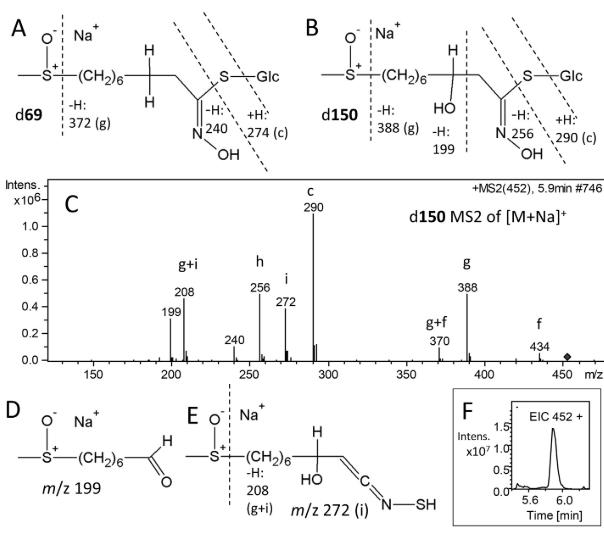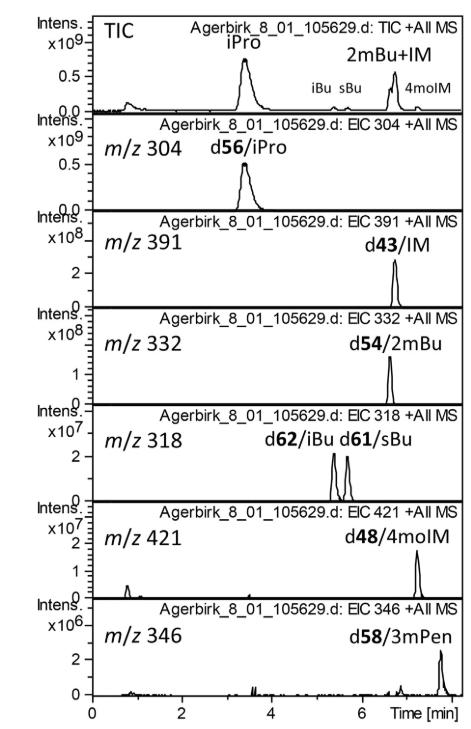What is Glucosinolate?
Glucosinolates are a class of natural compounds found in cruciferous plants (such as broccoli, mustard, and kale). They consist of a sugar molecule combined with a sulfur-nitrogen group and play essential roles in plant defense and adaptation mechanisms. Glucosinolates are pivotal in processes like insect resistance, disease defense, and stress tolerance within plants. Additionally, they hold significance in plant nitrogen and sulfur metabolism.
Why Do We Provide Glucosinolate Analysis Services?
Creative Proteomics offers glucosinolate analysis services to delve into the intricate structures, compositions, and functionalities of these complex compounds, along with their potential applications in plant biology, nutrition, and medical research. Here are key reasons for providing this service:
Unveiling Plant Defense Mechanisms: glucosinolates serve as natural defense compounds in plants, countering insect pests and pathogens. By analyzing glucosinolate types and quantities in various plant samples, we can uncover plant responses to external stressors, aiding agricultural production and plant protection.
Advancing Nutritional Research: Some glucosinolates are associated with human health through dietary intake. Our analysis service helps identify glucosinolate content in different foods, offering valuable data for investigating the relationship between human diet and health.
Potential in Medical Research: Certain glucosinolates exhibit potential anti-cancer and anti-inflammatory activities. By analyzing the presence and content of these compounds in different plants, we provide valuable insights for drug development and medical research.
Ecology and Environmental Studies: Understanding glucosinolate content in different plants contributes to comprehending their roles in ecosystems and their impacts on soil and environmental health.
Glucosinolate Analysis Service at Creative Proteomics
At Creative Proteomics, we offer an extensive range of glucosinolate analysis services, each designed to provide detailed information about these intriguing metabolites. Our services include:
Profiling and Quantification: We employ advanced mass spectrometry-based techniques to accurately profile and quantify glucosinolates in plant samples. Our experts utilize cutting-edge instruments such as the Thermo Scientific Orbitrap Fusion Lumos mass spectrometer, which offers high-resolution and sensitivity for precise analysis.
Structural Elucidation: Through nuclear magnetic resonance (NMR) spectroscopy and tandem mass spectrometry (MS/MS) analysis, we elucidate the structural characteristics of various glucosinolates, unraveling their unique chemical properties.
Metabolomics Studies: Our comprehensive metabolomics studies provide a holistic view of glucosinolate metabolism in different plant tissues and under various conditions, aiding in the understanding of their biosynthesis and regulation.
Pathway Analysis: Creative Proteomics offers in-depth pathway analysis to elucidate the biosynthetic pathways of glucosinolates, shedding light on their interactions with other metabolites and their roles in plant physiology.
Glucosinolate Analysis Techniques
Thermo Scientific Orbitrap Fusion Lumos Mass Spectrometer
This high-resolution mass spectrometer excels in glucosinolate analysis. Its exceptional accuracy and sensitivity enable precise identification and quantification of glucosinolate molecules in different plant samples. Its advanced data processing capabilities enhance the reliability and accuracy of structural elucidation.
Agilent 6550 iFunnel Q-TOF Mass Spectrometer
This high-performance liquid chromatography mass spectrometer finds extensive application in glucosinolate analysis. Its high resolution, sensitivity, and wide range of mass spectrometry scan modes enhance the accuracy and reliability of identification and quantification of glucosinolates in complex samples.
Waters Xevo G2-XS QTof Mass Spectrometer
This quadrupole time-of-flight mass spectrometer also offers exceptional performance in glucosinolate analysis. Its rapid data acquisition speed and high-resolution capabilities facilitate high-throughput sample analysis while providing detailed information about glucosinolate structures and compositions.
 Workflow for Plant Metabolomics Service
Workflow for Plant Metabolomics Service
List of Glucosinolate Analyzed (including but not limited to)
| Allylglucosinolate |
Araban |
Dimethylglucosinolate |
Epiprogoitrin |
Gluconasturtiin |
| Glucoalyssin |
Glucoberteroin |
Glucobrassicin |
Glucocochlearin |
Glucodehydroerucin |
| Glucoerucin |
Gluconapin |
Glucoraphanin |
Glucoraphenin |
Glucohesperetin |
| Glucohesperin |
Gluconasturtiin |
Hydroxysinigrin |
Neoglucobrassicin |
Progoitrin |
| Sinalbin |
Sinigrin |
4-Hydroxyglucobrassicin |
4-Methoxyglucobrassicin |
|
Why Choose Us?
Agricultural Advancements: Elevate your agricultural practices by harnessing the power of glucosinolates. Our comprehensive analysis provides you with detailed insights into the glucosinolate profiles within your crops. Identify and select cultivars with higher glucosinolate content, paving the way for the development of pest-resistant and disease-tolerant varieties. Transform your fields into resilient ecosystems that thrive in the face of challenges.
Nutrition Insights: Step into the realm of nutrition with our precise glucosinolate analysis. Gain a thorough understanding of the glucosinolate content present in various foods. This knowledge empowers you to design nutritionally enhanced products that cater to the growing demand for functional foods. Craft offerings that seamlessly blend nourishment and vitality, shaping a healthier future for consumers seeking impactful dietary choices.
Health Potential: Embark on a journey of health and wellness exploration through glucosinolate analysis. Unearth bioactive compounds that hold potential therapeutic benefits. From anti-cancer attributes to anti-inflammatory properties, our analysis unlocks the door to a world of possibilities in pharmaceutical research. Leverage these insights to contribute to the development of transformative healthcare modalities.
Ecological Understanding: Delve into the intricate choreography of ecosystems with our glucosinolate analysis. Uncover the pivotal role that glucosinolates play in shaping ecological interactions. Gain a deeper understanding of their influence on herbivore-plant relationships, contributing to a holistic comprehension of nature's delicate balance. Illuminate the unseen narratives that drive ecological dynamics.
Sample Requirements for Glucosinolate Assay
| Sample Types |
Minimum Sample Size |
| Plant Samples |
Roots, stems and leaves, floral parts, fruits/seeds, rhizomes, buds/tender leaves, tissue sections, pollen, bark, trunk/wood, resin/gum, resin acids, seedlings/young plants, rhizosphere soil, root exudates. |
50 mg - 1 g |
Case 1. Diverse Glucosinolates: Evolutionary Insights & Advanced Analyses in Cardamineae Plants
Background:
Glucosinolates, secondary metabolites found in plants like broccoli and mustard, play roles in defense and health. The Cardamineae tribe in the Brassicaceae family offers a unique opportunity to study glucosinolate diversity. Phylogenetic analysis reveals evolutionary relationships, while advanced techniques like HPLC-DAD and HPLC-MS provide accurate profiling. Preparative HPLC and NMR aid structural characterization. This research sheds light on plant chemistry, evolution, and ecological interactions.
Samples:
The research collected plant samples from different localities, including Rorippa amphibia, Rorippa sylvestris, Cardamine diphylla, Cardamine impatiens, Cardamine pratensis, Iberis amara, Capparis spinosa, Crambe maritima, Brassica napus, Eruca sativa, and Arabidopsis thaliana. These samples were carefully collected and identified, and specific plant parts were chosen for analysis.
Methods:
Phylogenetic Analysis:
- 161 taxa from the Cardamineae tribe were selected with available DNA sequence data.
- Nuclear encoded internal transcribed spacers 1 and 2 (ITS) were used for phylogenetic analysis.
- Alignment was prepared using MAFFT and adjusted manually. The alignment consisted of 677 bp.
- Maximum-likelihood (ML) and Bayesian inference (BI) analyses were performed to establish evolutionary relationships.
- The best fitting nucleotide substitution model was determined using MrModeltest.
Glucosinolate Analysis:
- Glucosinolates were analyzed using HPLC-DAD and HPLC-MS methods.
- Lyophilized samples were extracted in boiling 70% aq. MeOH.
- On-column enzymatic desulfation with purified sulfatase was performed.
- Quantification was relative to an external standard (allylGSL) using accepted response factors.
- HPLC-DAD utilized various columns, including Supelcosil LC-ABZ, Luna C18, and Luna Phenylhexyl.
- HPLC-MS employed an Agilent 1100 Series HPLC coupled with a Bruker HCT-Ultra ion trap mass spectrometer.
- Mass spectrometry was done in positive electrospray mode, and MS2 and MS3 spectra were acquired.
- Quantitation of major peaks was by UV using appropriate response factors. Tentative quantitation of minor peaks was done using HPLC-MS.
Preparative HPLC and NMR:
- Preparative isolation of desulfoglucosinolates followed the analytical protocol with moderate up-scaling.
- Ion exchange columns were used, eluates were combined and concentrated, and then subjected to HPLC on the same column.
- Fractions were collected, dried, and analyzed using NMR equipment operating at 400 MHz (1H) or 100 MHz (13C), with D2O as solvent and dioxane as reference.
Results
The study revealed comprehensive information about glucosinolate profiles in the investigated plant species. Phylogenetic analysis provided insights into the evolutionary relationships within the Cardamineae tribe. HPLC-DAD and HPLC-MS analyses allowed for the identification and quantification of glucosinolates. Additionally, preparative HPLC and NMR techniques enabled the isolation and structural elucidation of desulfoglucosinolates. The results contribute to a better understanding of glucosinolate diversity and distribution in various plant taxa.
In summary, this research investigated glucosinolates in different plant species using phylogenetic analysis, HPLC-DAD, HPLC-MS, preparative HPLC, and NMR techniques. The findings offer valuable insights into the chemical composition and evolutionary relationships of these plants.
 Elucidation of a novel glucosinolate structure, 150, from ion trap MS2 data of the sodium adduct of the desulfated derivative d150
Elucidation of a novel glucosinolate structure, 150, from ion trap MS2 data of the sodium adduct of the desulfated derivative d150
 Exploration of the glucosinolate profile of Cardamine diphylla foliage by HPLCMS of desulfated derivatives.
Exploration of the glucosinolate profile of Cardamine diphylla foliage by HPLCMS of desulfated derivatives.
Reference
- Olsen, Carl Erik, et al. "Glucosinolate diversity within a phylogenetic framework of the tribe Cardamineae (Brassicaceae) unraveled with HPLC-MS/MS and NMR-based analytical distinction of 70 desulfoglucosinolates." Phytochemistry 132 (2016): 33-56.


 Workflow for Plant Metabolomics Service
Workflow for Plant Metabolomics Service Elucidation of a novel glucosinolate structure, 150, from ion trap MS2 data of the sodium adduct of the desulfated derivative d150
Elucidation of a novel glucosinolate structure, 150, from ion trap MS2 data of the sodium adduct of the desulfated derivative d150 Exploration of the glucosinolate profile of Cardamine diphylla foliage by HPLCMS of desulfated derivatives.
Exploration of the glucosinolate profile of Cardamine diphylla foliage by HPLCMS of desulfated derivatives.

